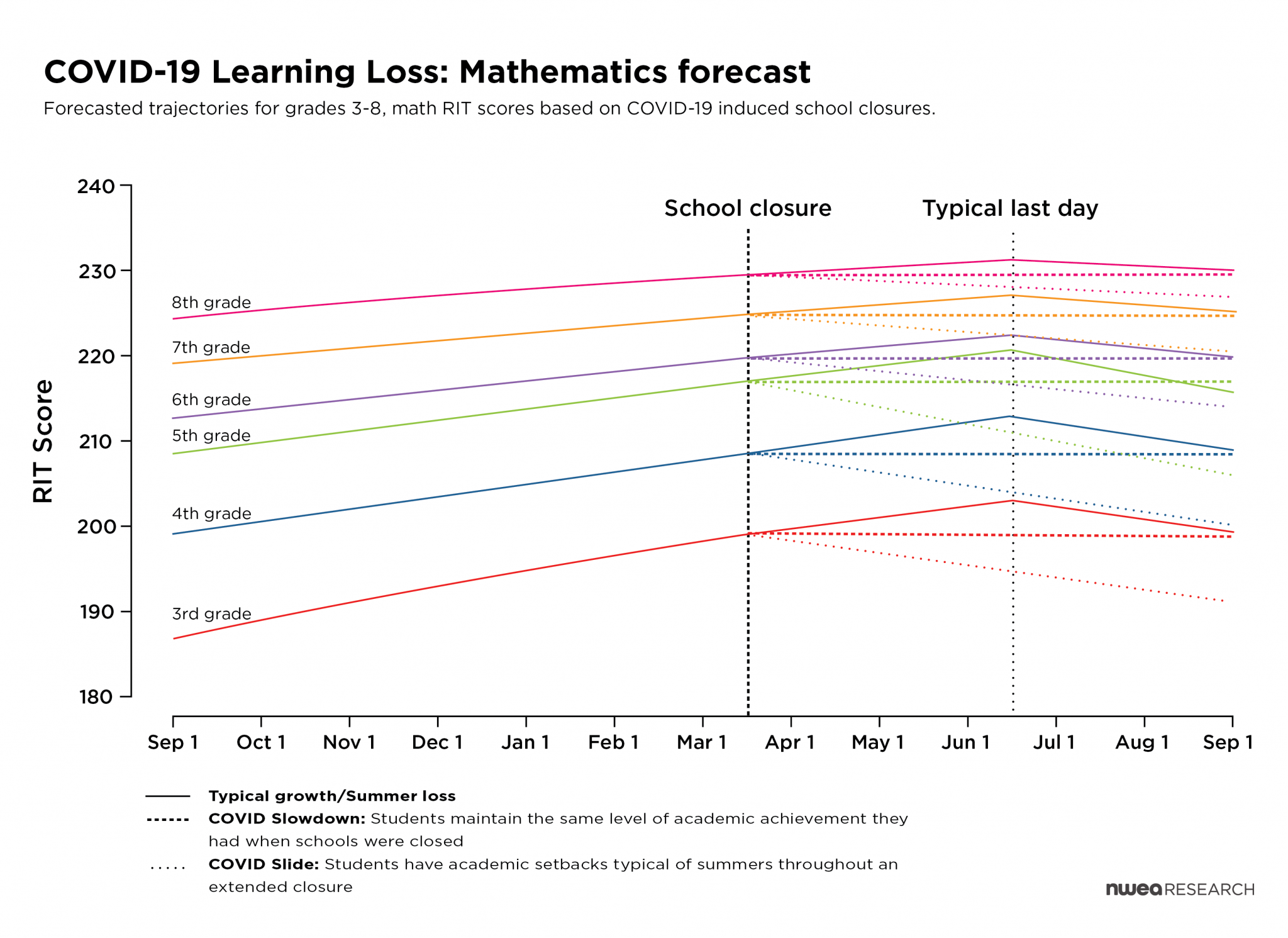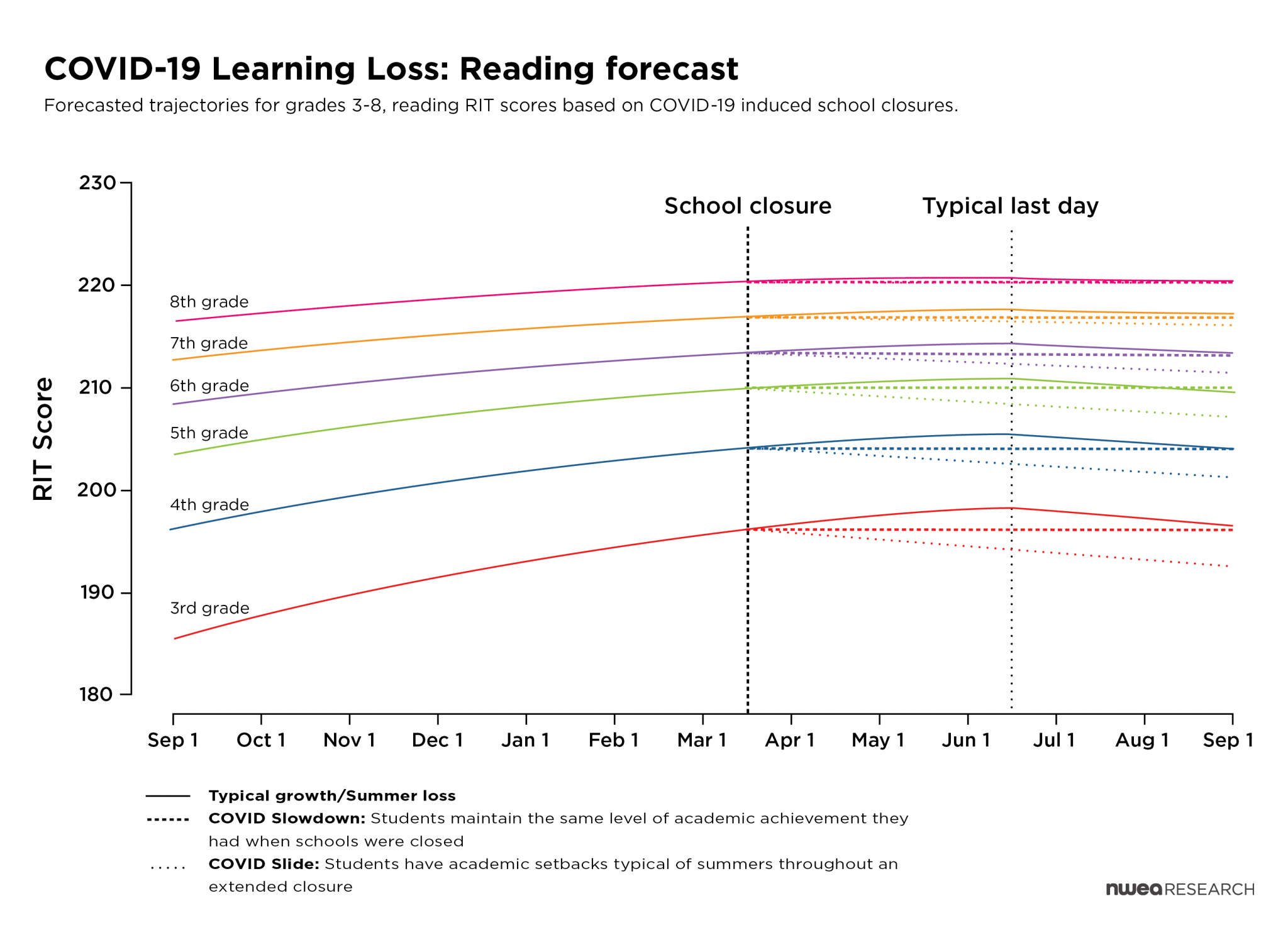New Research from NWEA Projects Major Academic Impacts from COVID-19 Closures for Students, Especially in Mathematics
Schools should be prepared for some students to be nearly a year behind in math come fall
Portland, Ore. – April 9, 2020 – NWEA, a not-for-profit provider of assessment solutions, released today projections that current school closures due to the COVID-19 global pandemic could result in substantially lower achievement levels for students. The forecasts leveraged previous NWEA research on summer learning loss (also known as summer slide) and used a national sample of over five million students in grades 3-8 who took MAP® Growth™ assessments to estimate potential impacts of the COVID-19 related school closures.
The research compared academic achievement trajectories during a typical school year for grades 3 – 8 where no disruption to learning took place, to two scenarios for the closure: a COVID-19 slide, in which students showed patterns of learning loss typical of summers throughout an extended closure, and COVID-19 slowdown, in which students maintained the same level of academic achievement they had when schools were closed (modeled for simplicity as beginning March 15) until schools reopened.
Preliminary estimates suggest impacts may be larger in mathematics than in reading, and that students may return in fall 2020 with less than 50% of typical learning gains, and in some grades, nearly a full year behind what we would expect in this subject under normal conditions.

For reading, the outlook is a bit more optimistic. However, forecasts suggest some students will return in fall with about 70% of the learning gains relative to a typical year.

“Taken together, these forecasts parallel many education leaders’ fears: missing school for a prolonged period will likely have major impacts on student achievement come fall,” said Beth Tarasawa, EVP of Research at NWEA. “The COVID-19 crisis is a call to action for practitioners and policy makers alike. We must be prepared to support students, many of whom will likely be behind academically.”
NWEA researchers provide caution around these projections. While the COVID-19 school closures have some characteristics in common with a summer break, many school systems across the country are implementing various online curriculum, instruction, and progress monitoring resources to offset the disruption and maintain learning gains. However, the aspects of trauma and the current economic conditions of joblessness, and the increase in the number families facing food insecurity and homelessness could make academic projections even bleaker for populations most historically marginalized.
Like epidemiologists who have public health projections, NWEA’s academic forecasts present the education community with a moral imperative and push to ask: How do we support educators and families during and after the COVID crisis? What can we do to mitigate these academic projections?
To pursue answers to these questions and start pushing recovery efforts forward immediately, NWEA is recommending the education community focus on the following actions:
Leverage state and federal investments and flexibilities to close the inevitable gaps – now and in the future.
- Federal relief funds will be making their way to state education agencies, local education agencies and government offices to help meet “emergency needs.” In addition, federal legislation and the U.S. Department of Education have provided a number of flexibilities around the use of funds to better serve immediate needs.
- Districts and state governing bodies need to work collaboratively to plan most effectively for those funds and together prioritize communities in greatest need. Make up lost instructional time. Provide more time with teachers—whatever it takes.
- Any options for added instructional time are essential to slow the slide: summer school, extended school days, and year-round schooling options should all be considered and funded. State and district policymakers should also consider removing potential barriers to these supports, such as statutory requirements around school start and end dates.
- Additional summer learning programs, including libraries and existing state supports across the nation should be funded now for both reading and math initiatives. Create very clear, strategic restart plans for schools now.
- Implement measures to identify where students are academically and
emotionally. Identify how instruction needs to be restructured to fit the needs of the students. - Get creative with scheduling to maximize instructional time: seek flexibility on typical time requirements for certain classes, require structured use of supplemental learning materials (beyond homework), extend hours
- Triage trauma and prioritize the most severe learning gaps. Restructure instructional supports to address introductory and mastery moments that were missed during the closures.
- Prioritized plans for students from special populations – including guidance for accommodations and assistive technology, and specific strategies for supporting English language learners, families experiencing homelessness, and other marginalized groups. Surround kids with learning outside the classroom
- Engage local government entities, like Parks & Recreation, to provide funding for enrichment programs and quality, free learning programs for kids. Pair meal and nutritional programs with engaging learning opportunities.
- Engage local businesses that have endured the economic fallout to step up and provide learning supports to children in their communities. For example, there are thousands of literacy and mathematics opportunities for K-8 students in a grocery store—imagine what’s possible when key sectors of the business community fully participate.
Use the demand for distance learning as a catalyst to create more blended learning options
- Provide funding infrastructure for distance learning, including platforms, technology, connectivity, and training for practitioners.
- When schools open and recovery begins, use what we have learned in this crisis and expand on it to prepare for the future.“Given NWEA’s depth of research and our partnerships with other mission-driven organizations, we’re in a unique position to offer valuable insights to the education community as we navigate through this crisis,” said Chris Minnich, CEO of NWEA. “Together, we can mitigate the impact on kids – especially for those most vulnerable in our population and continue our efforts to reach every student.”
View the full analysis at nwea.org/covid-slide.
About NWEA
NWEA® is a mission-driven, not-for-profit organization that supports students and educators worldwide by creating assessment solutions that precisely measure growth and proficiency— and provide insights to help tailor instruction. Educators in more than 10,000 schools, districts, and education agencies in 146 countries rely on our flagship interim assessment, MAP® Growth™; our progress monitoring and skills mastery tool, MAP® Skills™; our reading fluency and comprehension assessment, MAP® Reading Fluency™ ; our personalized learning tool powered by Khan Academy, MAP® Accelerator™; and our new assessment solution that combines growth and proficiency measurement.
Visit NWEA.org to find out how NWEA can partner with you to help all kids learn.
Contact: Simona Beattie, Sr. Manager, Public Relations, simona.beattie@nwea.org or 971.361.9526.